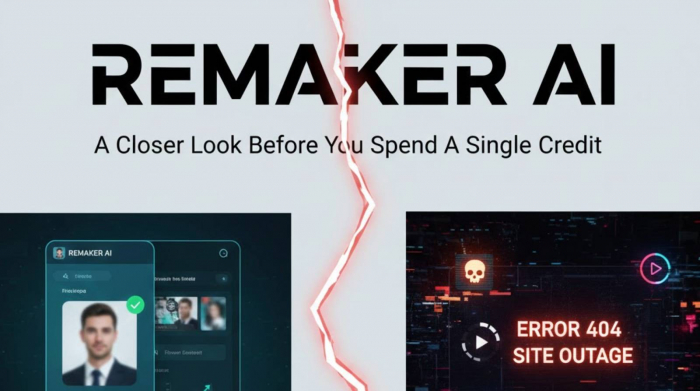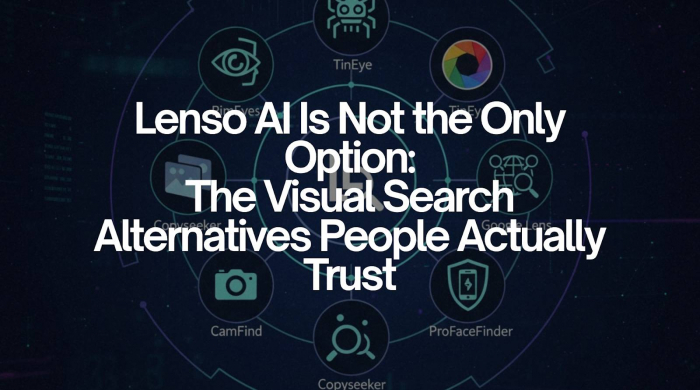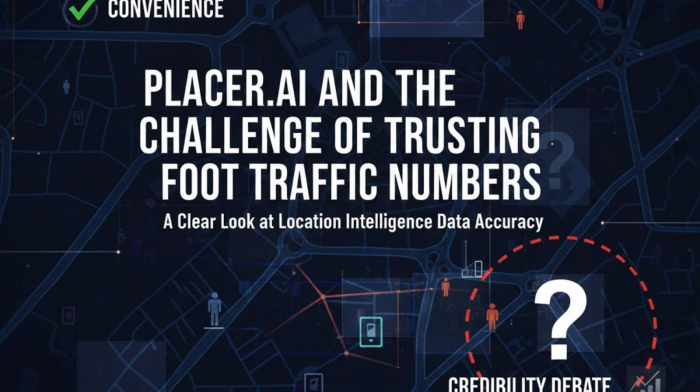Table of Content
- From Frustrated Editing to Text-Based Freedom
- Why I Needed Something Beyond Traditional Video Editors
- The First Time I Tried Editing a Video Like a Document
- The AI That Became My Co-Editor (and Sometimes My Enemy)
- When Audio Cleanup Saved My Podcast Episode
- Speaking in My Own AI Voice: Cool or Creepy?
- The Awkward Silence That Made Me Try Descript’s Filler Word Removal
- Turning a Messy Webinar Into Shareable Clips Overnight
- My First Experience With Screen Recording & Remote Sessions
- The Day I Trusted AI to Write My Show Notes
- Fixing Eye Contact Without Re-Shooting
- Captions That Looked Branded, Not Auto-Generated
- How Multilingual Transcription Helped Me Expand Reach
- Descript’s AI Avatars: Helpful, Hilarious, or Gimmicky?
- When I Hit the Wall With Export Options
- The Fine Print Behind the Free Plan
- The Editing “Magic Moments” That Keep Me Coming Back
- What Other Creators Really Say About Descript
- When Descript Shines vs. When It Stumbles
- Would I Still Recommend Descript in 2025?
- FAQ
- Final Verdict
From Frustrated Editing to Text-Based Freedom
I used to dread editing. Whether it was a podcast episode or a short video tutorial, I’d spend hours scrubbing timelines in Premiere, trimming clips frame by frame, and manually deleting filler words. The workflow was exhausting and often killed my creative momentum.
That’s when I discovered Descript. Their pitch was bold: “Edit audio and video the way you edit text.” At first, it sounded like marketing fluff. But curiosity got the better of me—and that’s when everything changed.
Why I Needed Something Beyond Traditional Video Editors
Traditional tools like Premiere Pro or DaVinci Resolve are great for cinematic projects. But as a creator focused on podcasts, YouTube tutorials, and business explainers, I didn’t need Hollywood-level VFX. What I needed was speed, clarity, and simplicity.
Descript’s video editor gave me exactly that. Instead of feeling like a video technician, I felt like a storyteller again.
The First Time I Tried Editing a Video Like a Document
My first project with Descript blew me away. I uploaded a clip, and within minutes, it generated a transcript. When I deleted a sentence in text, the corresponding audio and video vanished too. No waveforms, no timeline headaches—just words controlling visuals.

It was like writing in Google Docs, except the “backspace” key also cleaned up my footage. Zapier’s review perfectly captures this: Descript feels like the “Google Docs of video editing.”
The AI That Became My Co-Editor (and Sometimes My Enemy)
Descript’s AI assistant, Underlord, felt like a co-editor. It could:
- Remove filler words automatically.
- Shorten long silences.
- Suggest highlight clips.
- Draft podcast show notes.
Most of the time, it saved me hours. But sometimes it went too far—cutting pauses I actually wanted to keep. That’s when I learned: AI in Descript works best as a helper, not a replacement.
When Audio Cleanup Saved My Podcast Episode
One of my podcast recordings was nearly ruined by background hum. Normally, I’d panic and reschedule. Instead, I tried Studio Sound, and in seconds, it polished my voice, reduced noise, and turned an unusable recording into something professional. EasyWithAI highlights this feature for a reason—it’s a lifesaver.
Speaking in My Own AI Voice: Cool or Creepy?
I tested Descript’s AI voices and cloned my own voice. The first time I typed text and heard it spoken in my tone, it was eerie. But practically? It was a huge time-saver. Instead of re-recording intros, I fixed mistakes by typing new lines.
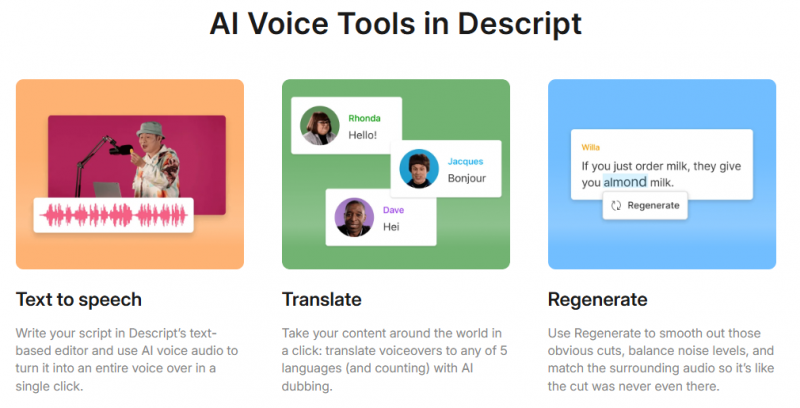
The Awkward Silence That Made Me Try Descript’s Filler Word Removal
Scrolling through my first transcript, I saw hundreds of “ums” and “uhs.” Deleting them all would have taken forever—until I clicked “Remove Filler Words.” In seconds, the clutter was gone.
Turning a Messy Webinar Into Shareable Clips Overnight
I once imported a two-hour webinar into Descript. Normally, editing that down would take days. But by highlighting key sections in the transcript, I quickly generated multiple social-ready clips with captions. Howfinity explains this exact workflow—and it’s become one of my favorites.
My First Experience With Screen Recording & Remote Sessions
Descript also has built-in screen recording and Rooms for remote interviews. Instead of juggling Zoom and separate audio recorders, I captured everything inside Descript. It simplified my process more than I expected.
The Day I Trusted AI to Write My Show Notes
Podcast show notes used to take me an hour. With Underlord, I got a draft in seconds. Sure, I had to tweak it—but the heavy lifting was done. Deepgram highlights how Descript’s transcripts fuel faster content, and that matches my experience.
Fixing Eye Contact Without Re-Shooting
In one video, I wasn’t looking at the camera enough. Normally, I’d reshoot. Instead, I used Descript’s Eye Contact feature, which digitally corrected my gaze. Suddenly, I looked more confident—without recording a second take.
Captions That Looked Branded, Not Auto-Generated
Most auto captions look clunky. Descript’s caption editor let me style them with my brand colors and fonts. It made my videos feel polished and on-brand.
How Multilingual Transcription Helped Me Expand Reach
With transcription in 25+ languages, I repurposed content for Spanish-speaking viewers. Accuracy wasn’t perfect, but it was enough to expand my audience.
Descript’s AI Avatars: Helpful, Hilarious, or Gimmicky?
I tested Descript’s text-to-speech avatars. Some looked realistic, others awkward. They’re great for explainer content—but I wouldn’t replace myself for serious projects.
When I Hit the Wall With Export Options
The free plan only allows 720p exports with watermarks. For YouTube, that’s unusable. I upgraded for 1080p and later 4K exports. Descript’s pricing makes this clear: the free plan is just to get you hooked.
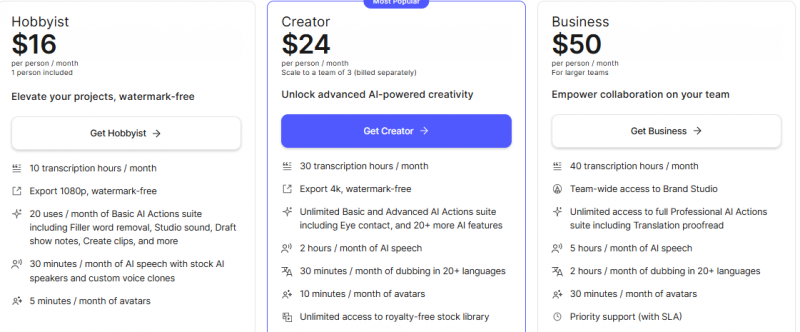
The Fine Print Behind the Free Plan
The free tier includes only 1 hour of transcription per month. I blew past that in a single podcast. Many Reddit users echo the same frustration—you’ll outgrow it fast.
The Editing “Magic Moments” That Keep Me Coming Back
The three features that keep me loyal:
- Studio Sound for audio cleanup.
- Filler word removal for instant polish.
- Clip repurposing for social media.
These aren’t gimmicks—they save me hours every week.
The Overhyped Features That Didn’t Match My Workflow
Not everything impressed me. AI avatars felt gimmicky, and clip suggestions weren’t always accurate. For professionals, these features need refinement.
How Descript Fits Into a Pro Editor’s Toolkit (Or Doesn’t)
Descript didn’t replace DaVinci Resolve for cinematic work. But for podcasts, shorts, and training videos, it became my go-to. For me, Descript is a complement, not a replacement.
Descript for Business Teams: Collaboration Done Right?
With Brand Studio, teams can keep captions, styles, and templates consistent. For agencies, this is a huge time-saver.
What Other Creators Really Say About Descript
Positive: Easy to learn, saves time (G2 reviews).
Negative: Stability issues, limited for pro editors (Reddit critique).
Mixed: Trustpilot shows both praise and frustration.
When Descript Shines vs. When It Stumbles
Shines: Podcasts, webinars, training videos, social clips.
Stumbles: Feature films, advanced color grading, heavy VFX.
The Day I Paired Descript With Another Tool
I edited the core audio/video in Descript, then polished color and graphics in DaVinci Resolve. It was the best of both worlds.
How Descript Changed My Workflow Forever (But Didn’t Replace Everything)
Now, I start almost every project in Descript. It removes the friction, gets me 80% there, and frees me to focus on creative polish.
Would I Still Recommend Descript in 2025?
Yes—for creators, coaches, and teams who value speed. No—for filmmakers needing deep control. Notta’s review sums it up best: Descript is brilliant for efficiency, not perfection.
FAQ
Is Descript good for beginners?
Yes, it’s as simple as editing a doc.
Does Descript support voice cloning?
Yes, with consent (AI voices).
What are its downsides?
Stability, hidden AI limits, weak pro features.
Final Verdict
For me, Descript has been a game-changer. It’s not perfect, and it won’t replace pro editors. But as a time-saving, AI-powered editing tool for everyday creators, it delivers exactly what it promises—editing that feels as easy as writing.
Post Comment
Be the first to post comment!
